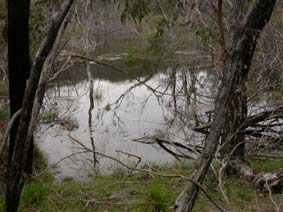Major Group: Insecta
Order: Coleoptera
Family: Heteroceridae |
Descriptive Features:
Adults
antennae short, no distinct club
frontoclypeal suture distinct
posterior edge of pronotum simple
elytra exposing less than 2 complete abdominal tergites
abdomen with at least 3 connate ventrites
pubescent
mesocoxal cavities moderately to widely separated
ventral portion of the notum, (hypomeron) on each side joined directly to the sternum by notosternal suture
pleuron reduced and concealed
outer edge of middle tibia bearing spines or teeth along most of its length
tarsi 4-segmented, simple
size: 3 - 4mm
Larvae
antennae 3-segmented
labrum separated from head capsule by complete suture
maxillary palps 3-segmented
mandibular mola present
basal portion of labium completely or almost completely connate with maxillae
bases of frontal arms distinctly separated
body elongate
legs well-developed
size: |

|
Heterocerus larva |
|
|

|
Heterocerus sp. adult |
|
Taxonomic Checklist: Genera
Elythomerus elongatus Waterhouse, 1874
Heterocerus debilipes Blackburn
Heterocerus flindersi Blackburn
Heterocerus largensis Blackburn
Heterocerus mastersi Macleay
Heterocerus scabriusculus Charpentier
Heterocerus simillimus Charpentier
Heterocerus subpilosus Charpentier |
|
Distribution:
Elythomerus Qld
Heterocerus Australia wide
Sensitivity Rating: SIGNAL grade 1
Functional Feeding Group: uncertain
|

|
Mitta Mitta River below Dartmouth Dam, Vic |
|
|
Ecology: Instream habitat: Adult and larval heterocerid beetles occur within moist mud or sand at the edge of fresh and brackish watercourses, lakes and ponds particularly in arid and semiarid inland regions. Larvae excavate subsurface tunnels and adults reside in their own tunnels with entrances marked with sand ‘chimneys’.
Feeding ecology: All Heteroceridae stages feed on zooplankton, algae, diatoms, and organic debris.
Habit: Australian adults are readily attracted in large numbers to light
Life history: Eggs are laid in small masses in breeding chambers. Pupation takes place in a mud cell.
|
| |
Information Sources: Lawrence 1992, Lawrence & Britton 1991, Calder 1999b, Williams 1980
Key to Genera: Charpentier 1968 (Notogean region)
Key to Species: Charpentier 1968 (Notogean region) |
|
|
|